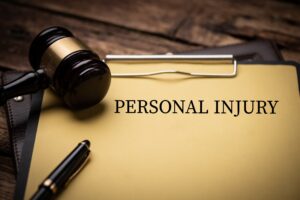This guide will give key information on the time limit for public liability claims. There is a limitation period that states when legal proceedings need to be started. As you move through our guide, you can find information on the limit that generally applies, as well as exceptions that can be made.
Additionally, we will discuss the eligibility criteria that need to be met in order to begin a personal injury claim following a public place accident. It will also give examples of the types of evidence that could be helpful to a claim.
Later on, the guide will explore the responsibilities the party in control of a public space has with regard to the safety of those visiting and using the space. Additionally, it will give some examples of public liability accidents, as well as noting some of the injuries that could be sustained, and the compensation that could be awarded to address your pain and suffering.
Finally, the guide concludes with insight into the benefits of getting expert help from our panel of personal injury solicitors, and how they could assist you if your claim is valid.
If you have questions about public liability claims or how you can start your own, please use any of these details to reach our advisors:
- Contact us through our online form;
- Call 0161 696 9685;
- Speak to an advisor on live chat below.
Select A Section
- What Is The Time Limit For Public Liability Claims?
- Eligibility To Make Public Liability Claims
- What Evidence Do You Need To Make A Public Accident Claim?
- Examples Of Public Liability Claim Settlements
- Why Choose A No Win No Fee Agreement?
- Further Guidance On The Time Limit For Public Liability Claims
What Is The Time Limit For Public Liability Claims?
The Limitation Act 1980 sets a time limit to give claimants reasonable time frames in which to pursue a claim. Beginning a claim in good time benefits all parties, as it ensures that evidence and testimony are more likely to be both available and accurate.
Generally, the time limit for starting personal injury claims is three years from the accident date. There are some exceptions, however. For example:
- When an injured person lacks the mental capacity to claim for themselves the time limit is paused indefinitely. Should they recover and no claim have been made on their behalf in the intervening period, they would have three years from the recovery date to start their claim.
- The three-year time limit for a minor under the age of 18 begins once they turn 18, as they cannot start a claim themselves before then.
While the time limit is inactive a court-appointed representative of the injured person, known as a litigation friend, may start a claim on the injured person’s behalf.
If you have questions about the time limit for public liability claims, please contact our advisors to discuss your situation.
Eligibility To Make Public Liability Claims
In addition to adhering to the time limit for public liability claims, other eligibility criteria must be met for any personal injury claim to be valid. These criteria are:
- That an occupier of a public space owed you a duty of care;
- They breached their duty of care; and
- The accident this breach caused then led to your injuries.
The Occupiers’ Liability Act 1957 applies a duty of care to occupiers, laying out the requirement to take any steps that ensure the reasonable safety of visitors on the premises.
Such safety measures include removing or signposting hazards or performing a risk assessment and addressing any issues they become aware of. In the event that reasonable steps are not taken, the occupier could be in breach of their duty of care. If that happens, then accidents and injuries could occur.
Causes Of Public Liability Accidents
Examples of possible public accidents and subsequent injuries include:
- An accident in a shop where a slip on a wet floor, that hasn’t been cleaned up or signposted, causes you a wrist injury.
- A gym injury, wherein using faulty equipment gives you a broken or fractured bone.
- An arm injury sustained in a public park accident where you fall off a broken park bench.
- Tripping on a pavement that is badly cracked and suffering a major ankle injury.
It’s important to note that not all accidents in a public place will form the basis of a valid claim. However, please call our team if you have evidence that a breach of duty on the part of an occupier caused you harm. They can assess whether you have an eligible claim.
What Evidence Do You Need To Make A Public Accident Claim?
Starting legal proceedings within the time limit for public liability claims gives the opportunity to gather relevant evidence that shows you suffered injuries resulting from a breached duty of care. This includes:
- Footage from CCTV or a personal device showing the accident and its cause.
- Photographs which illustrate the accident scene, plus any visible injuries.
- Witness contact details so that their accounts can be collected during a claim.
- Medical records showing your injuries that you can request during your treatment.
- A diary of your treatment and symptoms, which can highlight your physical and mental state after the accident.
If you have a valid claim and seek legal representation, a solicitor could assist you in collecting evidence. To that end, please speak to our advisors to find out how a solicitor from our panel could help you seek compensation..
Examples Of Public Liability Claim Settlements
There are two possible heads of claim in a personal injury settlement, the first being general damages. This head of claim aims to compensate for the pain and suffering that results from injuries, whether physical or psychological.
Legal professionals can use medical evidence to help them assign value to injuries. They can also refer to the Judicial College Guidelines (JCG), which we have used to set out the table below. It contains guideline compensation brackets as listed in the JCG.
Please note, however, that this table is a guide and should not be considered a guarantee of what you would receive in general damages.
Compensation Table
| Injury | Severity | Compensation - Guidelines | Notes |
|---|---|---|---|
| Arm | Severe | £96,160 to £130,930 | Injuries that do not need amputation, such as a serious brachial plexus injury, that leaves the person little better off than if the arm had been lost. |
| Knee | Severe (i) | £69,730 to £96,210 | Joint disruption, osteoarthritis, lengthy treatment and significant pain and loss of function from a serious knee injury. |
| Leg | Severe (ii) | £54,830 to £87,890 | Very serious injuries where the injured person needs mobility aids, such as crutches, for the rest of their life, and has permanently impaired mobility. |
| Wrist | Complete loss of function | £47,620 to £59,860 | An example is where a joint fusion, known as an arthrodesis, has been performed. |
| Elbow | Severe | £39,170 to £54,830 | Injuries that cause a disability of a severe nature. |
| Ankle | Severe | £31,310 to £50,060 | A significant residual disability, such as ankle instability and a severely limited ability to walk. Pins and plates will have been inserted. |
| Back | Moderate (ii) | £12,510 to £27,760 | Examples of injuries in this bracket include ligament and muscle disturbance, causing backache. |
| Neck | Moderate (ii) | £13,740 to £24,990 | This bracket includes cases of wrench-like or soft tissue injuries, and more severe disc lesions causing cervical spondylosis. |
| Shoulder | Serious | £12,770 to £19,200 | Shoulder and neck pain resulting from shoulder dislocation or lower brachial plexus damage. |
How Special Damages Could Also Compensate You
You could also claim for monetary costs resulting from your injuries as part of the second head of claim, special damages. Among the financial losses you could claim are:
- Travel costs, if the injuries cause you to pay for travel you wouldn’t have otherwise taken.
- Medical or healthcare fees if you need extra support for your pain. This would also include any prescriptions you had to pay for.
- Mobility equipment or home adaptations if your injuries cause a disability that makes them a requirement.
- A loss of earnings if you had to miss work.
For more information on the personal injury compensation you could be awarded following a successful claim, please contact an advisor on the number above.
Why Choose A No Win No Fee Agreement?
If you meet the eligibility requirements to start a claim, you could get the support of a personal injury solicitor from our panel. They could help you throughout the claims process and will look to maximise your case’s chance of success.
Additionally, you could be offered a form of No Win No Fee contract known as a Conditional Fee Agreement (CFA.)
Under this contract, you would not pay a fee to your solicitor for their work upfront or during the case. While your solicitor would take a percentage of your compensation in a successful case – which is capped by the Conditional Fee Agreements Order 2013 – you will not pay this fee if the claim fails.
Contact Us
For anything from an answer to your question about public liability claims to a free assessment that helps you learn if you could make a claim, please get in touch with our advisors. You can speak to an advisor at a time of your choosing. Furthermore, there is no obligation to start a claim.
You can reach an advisor any time by:
- Calling 0161 696 9685;
- Going online to contact us;
- Clicking on the live chat option below.
Further Guidance On The Time Limit For Public Liability Claims
We have more guides which could help you, such as the ones below:
- How to claim for an accident on public transport.
- A guide on claims against a local council.
- Learn whether you could claim for falling in the street.
- Learn about claiming for a trampoline accident with our helpful guide.
Also, these resources could help:
- GOV – Requesting CCTV footage.
- NHS – Find your nearest A&E.
- NHS – Guidance on asking for medical records.
Thank you for reading this guide on the time limit for public liability claims. If you have any additional questions, please get in touch using the number above.
Written by EM
Edited by MMI


